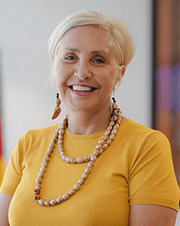Jody Broun facts for kids
Quick facts for kids
Jody Broun
|
|
|---|---|
 |
|
| Born |
Jody Broun
1963 (age 62–63) Perth, Western Australia
|
| Nationality | Aboriginal Australian |
| Occupation | Public servant and activist |
| Awards | Telstra National Aboriginal and Torres Strait Islander Art Award (1998) Canberra Art Prize (2005) |
Jody Broun (born 1963) is an Indigenous Australian artist and a leader who works to support Aboriginal and Torres Strait Islander communities. She is a Yindjibarndi woman from the Pilbara region of Western Australia.
As an artist, Jody has won major awards for her colorful paintings. As a leader, she has held important jobs in government, including her role as the Chief Executive Officer of the National Indigenous Australians Agency. Throughout her life, she has used her skills to help improve the lives of Indigenous people.
Contents
Personal Life and Background
Jody Broun was born in Perth, Western Australia, in 1963. Her family are Yindjibarndi people, and she has a strong connection to her traditional lands in the Pilbara region. This connection to the land and her culture has been a big inspiration for her art.
Jody's family has a difficult history. Her mother was part of the Stolen Generations. This means that when her mother was a child, she was taken away from her family by the government and forced to live on a mission. She was not able to see her family again until she was an adult. This experience in her family gave Jody a deep understanding of the challenges faced by Indigenous people.
From a young age, Jody learned the stories of her people and often visited her family's land. This helped her build a strong bond with her relatives and her culture. The beautiful landscapes of the Pilbara, with its rich colors and wide-open spaces, can be seen in many of her paintings.
A Career Helping Communities
For more than 30 years, Jody Broun has worked in jobs focused on helping Aboriginal people. She has worked at both the state and national levels of government.
Education and Early Career
Jody first trained to be a teacher. She taught at Clontarf Aboriginal College in Perth for several years. She also continued her own education, earning a Bachelor of Education and a Master's degree.
While teaching, she was also developing her skills as an artist. In 1998, she won a very important art award, the Telstra National Aboriginal and Torres Strait Islander Art Award.
Leadership Roles
After teaching, Jody took on leadership roles in government. She worked for many years to improve housing for Aboriginal people in both Western Australia and New South Wales. Her job was to make sure Indigenous families had access to safe and affordable homes.
She also served as the Director General of the NSW Department of Aboriginal Affairs NSW. In this role, she advised the government on important issues like community development, employment, and keeping children safe.
In 2011, she was elected Co-Chair of the National Congress of Australia's First Peoples. This group represents the voices of Indigenous Australians to the government. Later, she worked for the Australian Red Cross before taking on her current role as the head of the National Indigenous Australians Agency.
An Artist with a Message
Jody Broun is a well-known contemporary Indigenous artist. Her paintings are famous for their bright colors and unique style.
What Inspires Her Art?
Jody's art is inspired by her connection to her country, her family, and the history of Indigenous Australians. Her paintings often show the landscapes of the Pilbara, with its red earth and bright blue skies.
She sometimes paints from an aerial perspective, which is like looking down on the land from a plane. She also uses a "fisheye lens" effect in some paintings, which makes the view look curved and wide. This can be seen in her award-winning artwork, "White Fellas Come To Talk Bout Land."
Her art often tells a story about community, culture, and the impact of history on Indigenous people. She uses large canvases and acrylic paints to create her powerful images.
Famous Artworks
- "White Fellas Come To Talk Bout Land" (1998): This painting won a major national art award. It shows a meeting about land from a unique perspective.
- "Half-Time Game" (2005): This artwork won the Canberra Art Prize.
A Voice for Indigenous Rights
Jody Broun is an activist, which means she speaks out to create positive change for her community. She has been a strong voice for the rights of Aboriginal and Torres Strait Islander people for many years.
She has spoken about the need for fair treatment for Indigenous people and making sure they can access services like healthcare without facing problems. She has also been involved in campaigns like Close the Gap, which aims to improve the health and life expectancy of Indigenous Australians.
Jody has also spoken about why January 26 is a difficult day for many Indigenous people. She explains that while some celebrate Australia Day, for others it is a reminder of the beginning of a painful history for their ancestors. She uses her voice to honor the survival of Indigenous culture and to call for justice.
Major Awards
Jody Broun has won many awards for her art and has been a finalist in many competitions.
- 1998: Winner, Telstra National Aboriginal and Torres Strait Islander Art Award for "White Fellas Come To Talk Bout Land."
- 2005: Winner, Canberra Art Prize for "Half-Time Game."
- She was also a finalist for the Telstra National Aboriginal and Torres Strait Islander Art Award five other times.
Her artwork has also been chosen for the covers of books, reports, and calendars, especially those focused on Indigenous issues.

